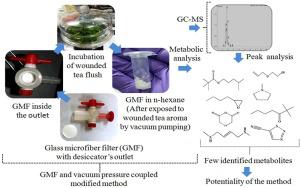Journal of Applied Research on Medicinal and Aromatic Plants ( IF 3.9 ) Pub Date : 2021-06-02 , DOI: 10.1016/j.jarmap.2021.100319 Pranjal P. Das

|
Under natural and ecological interaction like biotic and abiotic stresses, plants constitutively synthesize secondary metabolites which are extremely necessary for their normal growth and survival. Biogenic volatile organic compounds (BVOCs) are such secondary metabolites from adverse environmental conditions like different biotic/abiotic stresses where herbivory and mechanical wounding, such as leaf cuttings, are easily observed. However, BOVCs released from plucking injury on the young stem of Camellia sinensis (L.) O. Kuntze has very limited understanding which is usually experienced as “pleasing aroma” in the tea plantations. Moreover, “direct volatile injection” is a common method for BOVCs molecular characterization. In this work, a modified method, i.e., vacuum pressure coupled adsorption of BVOCs in glass microfiber filter, was used to firstly explore BOVCs from the stem injured young tea foliages (TV22), followed by molecular detection of its n-hexane fraction by GC-MS analysis. GC-MS chromatogram with stable baseline has shown the presence of a 13 (thirteen) lower MW metabolites (C2-C12) below 3 min of runtime which has signified the successful modification of earlier methods. In terms of power consumption, time, heat sensitive volatiles, and detection of low molecular weight/concentration metabolites, this method has strong advantages over the hydrodistillation method. Coupled with other downstream analyses, this method of extraction and detection of BVOCs of “pleasing aroma” from hand-plucked tea foliages has the potential to be observed for future application in perfume industry as a room, or body freshener.
中文翻译:

用于BVOCs的提取和检测玻璃微纤维为基础的方法茶树(L.)O. Kuntze
在生物和非生物胁迫等自然和生态相互作用下,植物组成性合成次生代谢物,这对于它们的正常生长和生存是极其必要的。生物挥发性有机化合物 (BVOC) 是来自不利环境条件(例如不同的生物/非生物胁迫)的次级代谢产物,在这些条件下,很容易观察到食草和机械损伤(例如切叶)。然而,对茶树幼茎采摘损伤释放的 BOVCs了解非常有限,在茶园中通常将其视为“令人愉悦的香气”。此外,“直接挥发注入”是 BOVCs 分子表征的常用方法。在这项工作中,一种改进的方法,即,玻璃微纤维过滤器中 BVOC 的真空压力耦合吸附,首先用于从茎受伤的幼茶树叶 (TV22) 中探索 BOVC,然后通过 GC-MS 分析对其正己烷组分进行分子检测。具有稳定基线的 GC-MS 色谱图显示存在 13(十三)个较低 MW 的代谢物(C 2 -C 12) 低于 3 分钟的运行时间,这意味着早期方法的成功修改。在功耗、时间、热敏挥发物和低分子量/浓度代谢物的检测方面,该方法比水蒸馏法具有很强的优势。结合其他下游分析,这种从手采茶叶中提取和检测“令人愉悦的香气”的 BVOC 的方法有可能在未来作为房间或身体清新剂应用于香水行业。



























 京公网安备 11010802027423号
京公网安备 11010802027423号